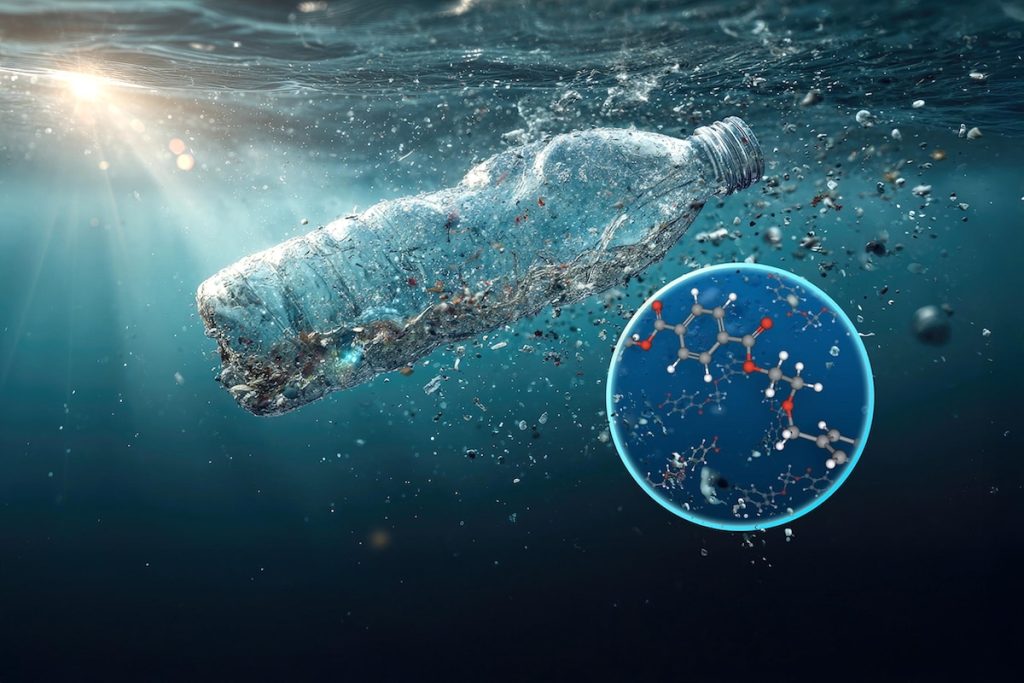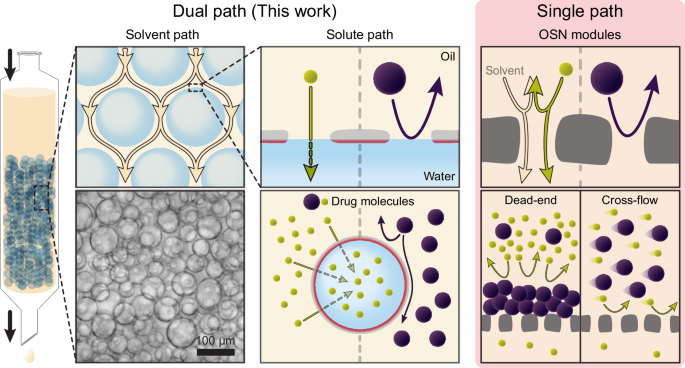
The North Atlantic water contains large quantities of nanoplastics, particularly plastics that are used to make disposable and reusable plastic bottles, films or disposable drinking cups and cutlery. ittipol, Adobe Stock / Graphic: Sebastian Wiedling, UFZ

Why you can trust us
Founded in 2005 as an Ohio-based environmental newspaper, EcoWatch is a digital platform dedicated to publishing quality, science-based content on environmental issues, causes, and solutions.
Nanoplastics — microplastics that are less than a micrometer in size — are found all over the world, from Alpine peaks to the deepest parts of the ocean.
At least 27 million tonnes of nanoplastics are estimated to be floating in the North Atlantic Ocean, weighing more than all wild land mammals combined, reported The New York Times.
Researchers from the Helmholtz Center for Environmental Research (UFZ), Utrecht University and the Royal Netherlands Institute for Sea Research investigated the prevalence of nanoplastics in the North Atlantic and found the tiny plastic particles at all ocean depths between the subtropical and temperate zones.
The findings of the study show that nanoplastics are a much bigger part of the marine plastics pollution problem than had been previously thought, a press release from UFZ said.
New @nature.com study by @dusanmateric.bsky.social & colleague from @utrechtuniversity.bsky.social: The North Atlantic’s mixed layer may contain up to 27 million tonnes of nanoplastics. Let that sink in: www.nature.com/articles/s41…
[image or embed]
— UFZ-CITE (@ufz-cite.bsky.social) July 10, 2025 at 4:00 AM
“Plastic pollution of the marine realm is widespread, with most scientific attention given to macroplastics and microplastics. By contrast, ocean nanoplastics (
Marine plastic waste causes devastating impacts to marine animals, who may become entangled in plastic debris such as bags and nets or ingest smaller pieces, mistaking them for food. Ingested plastic can injure or block the gastrointestinal tract and a small proportion of the tiniest plastic particles can enter the bloodstream by passing through the intestinal wall.
Until now, quantitative data on microplastics in the world’s ocean was scarce due to the particles’ small size, propensity to change and because they are often hard to distinguish from other particles in the environment using standard methods.
An expedition by a UFZ and Utrecht University research team aboard the Rv pelagia in 2020 recorded nanoplastic prevalence along a passage between the European continental shelf and the subtropical North Atlantic Gyre. The team took samples from a dozen measuring points: the uppermost ocean layer at approximately 10 meters; the intermediate layer at roughly 1,000 meters; and at 30 meters above the seabed.
“With the data from these measuring points, we can make statements about the vertical and horizontal distribution of nanoplastic in the North Atlantic,” said lead author of the study Dr. Dušan Materić, a chemist with UFZ, in the press release.
Our paper is out in Nature: “Nanoplastic concentrations across the North Atlantic”. An estimated 27 million tons of NPs are there, even at depths over 4500m. Huge thanks to my brilliant MSc student Sophie and the sampling support from NIOZ! @ufz.de @ufz-cite.bsky.social
doi.org/10.1038/s415…[image or embed]
— Dr.Dusan Materic (Matt) (@dusanmateric.bsky.social) July 9, 2025 at 11:17 AM
The researchers, led by Materić, measured concentrations of organic trace gases using thermal desorption and a high-resolution proton transfer reaction mass spectrometer (PTR-MS). They then used these to combust the nanoplastics. Heating them released gases that were able to be quantified with the mass spectrometer.
Materić, who developed the method at Utrecht University, explained that each polymer has a unique chemical fingerprint by which both its concentration and identity can be determined.
Nanoplastics were found at all analyzed depths of the 12 measurement sites.
“They are present everywhere in such large quantities that we can no longer neglect them ecologically,” Materić said.
The most frequently detected nanoparticles were polyethylene terephthalate (PET), polyvinyl chloride (PVC) and polystyrene (PS), which are commonly used to make plastic bottles, drinking cups, cutlery and films.
At almost all measuring points, these types of plastic were detected in the uppermost layer of the ocean.
“This is because, on the one hand, the redistribution from the atmosphere occurs via the sea surface and, on the other hand, a lot of plastic is introduced via the estuaries of rivers,” Materić explained.
The intermediate layer of the ocean was dominated by PET nanoparticles.
Materić said more nanoplastics were found in the North Atlantic subtropical gyre, where ocean currents are known to cause surface microplastics to accumulate.
The lowest nanoplastic concentrations were found near the sea floor. PET nanoplastics were detected at all points measured there, even at depths below 4,500 meters. This nanoplastic most likely came from fragmented synthetic clothing fibers, but could have also come from other unknown processes.
“Nanoplastic and nanoparticles are so small that the physical laws governing larger particles often no longer apply,” Materić said.
To their surprise, the researchers did not find any polypropylene (PP) or polyethylene (PE) — commonly used in packaging and bags — at any measuring points., even though they often end up becoming marine plastic waste.
The total amount of nanoplastics — approximately 27 million tonnes — are stored in the top layer of the Northern Atlantic Ocean, up to 200 meters deep, between the temperate and subtropical zones.
“This is in the same order of magnitude as the estimated mass of macro- and microplastics for the entire Atlantic,” Materić said.
Ocean nanoplastics have yet to be taken into account in current assessments of total marine plastics.
“Only a couple of years ago, there was still debate over whether nanoplastic even exists. Many scholars continue to believe that nanoplastics are thermodynamically unlikely to persist in nature, as their formation requires high energy. Our findings show that, by mass, the amount of nanoplastic is comparable to what was previously found for macro- and microplastic – at least in this ocean system,” Materić said.
The findings of the study, “Nanoplastic concentrations across the North Atlantic,” were published in the journal Nature.
High concentrations of nanoplastic particles were found in locations across the North Atlantic Ocean, particularly in the top 10 metres of water and near coastlines, according to an analysis in Nature. go.nature.com/44ohIok 🌊 🧪
[image or embed]
— Nature Portfolio (@natureportfolio.nature.com) July 10, 2025 at 9:04 AM








